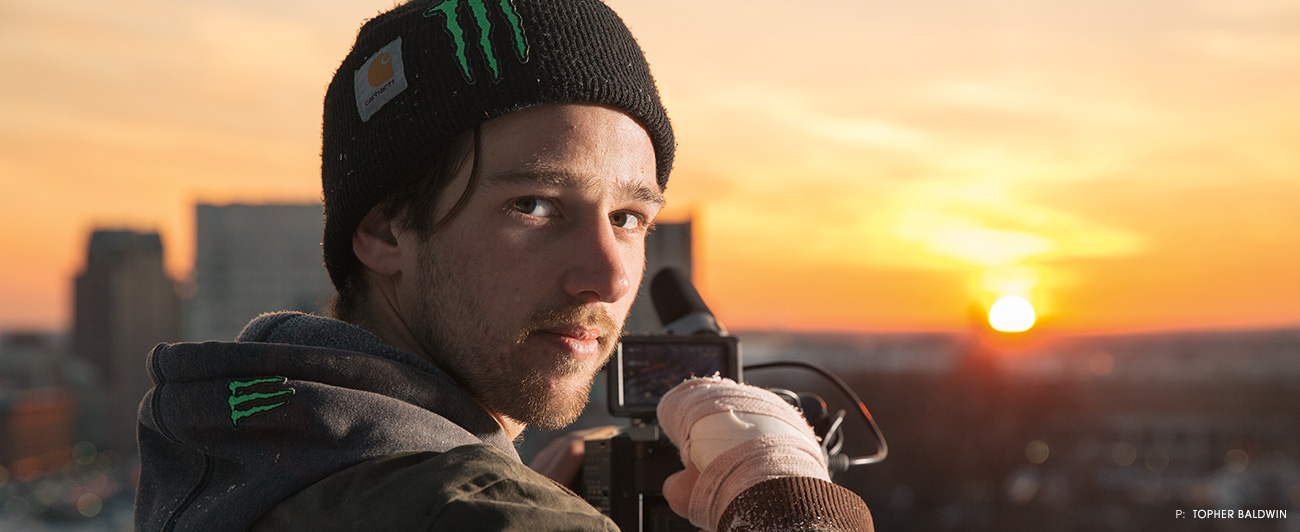Interview
Clayton Vila
Street Science: Clayton Vila and All the Little Things
Tiny Block Island, RI, is 14 miles east of Montauk Point, Long Island, NY, and 13 miles south of mainland Rhode Island. With a population just north of 1,000 and no notable hills, it may come as a surprise that one of those thousand residents would become one of the most influential street skiers of the last two generations. In Clayton Vila’s mind, however, he’s not really a skier in the common sense of the word.
Ten years ago, a young Vila, wearing a baggy, below-the-waist flannel and shorts, skied in his island backyard. He perfected tricks on a homemade Snowflex in-run to a PVC pipe rail. The surfer-turned-skier filmed and edited his homemade short, “Clayton Vila Shreds Block Island,” to the Lil Wayne track, “No Worries.”
When he published the edit on July 4, 2008, Vila foreshadowed his future pursuits—now 27 years old, he lives in Los Angeles where he self-directs his content and swings wide of mainstream editing styles to push the envelope of ski films as an art form. His debut documentary, For Lack of Better, earned Film of the Year at the Powder Awards in 2015. His 2018 film Back to Life, which chronicles the health struggles of standout freestyle competitor Torin Yater-Wallace, received critical acclaim after airing on ABC. It’s now entered into film festivals with the hope of making a long-shot Oscar run.
But Vila is still reluctant to call himself a skier. He’s a surfer who grew up at the beach. He’s a filmmaker, who’s now writing a screenplay while most skiers are waxing their gear and prepping for winter. He’s only a skier these days, for the most part, in the streets of major cities around the world, where it’s typically hard to find a skier at all.
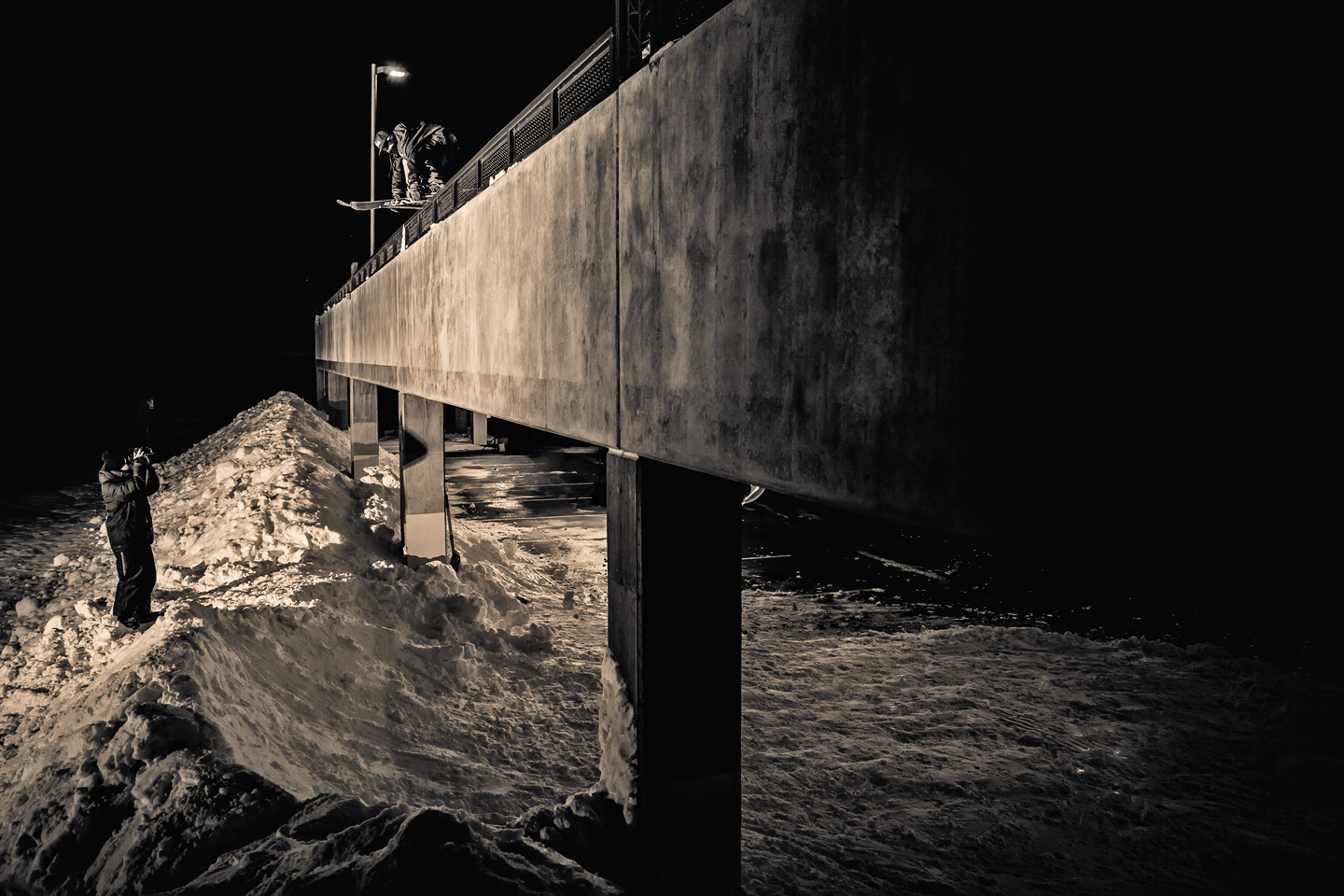
above In a quest for a full segment, features like this one can take up as little as :10 seconds in a full season, 2-3 minute edit. “I don’t even remember if Clayton was or wasn’t stoked on this one,” said photographer Erik Seo. “I just threw up some lights and did what I could to take a photo and show the scene as well as I could.” Photo: Erik Seo
In late August, I reached Vila by phone. He was back in Block Island, enjoying a homecoming of sorts before attending a Rhode Island film festival premiere of Back to Life. He’s no longer the tall-tee-wearing kid, who helped legitimize street skiing in front of the camera for Stept Productions. Today, he’s still a strong street skier, appearing in Teton Gravity Research’s new film, Far Out, but he’s also a clearheaded visionary with goals beyond skiing.
“Clayton has been a part of our camp for a long time,” TGR co-founder Todd Jones says. “Creatively, he’s much more than an athlete. He’s an artist. He has the camera chops. He made his short film FIVE and he broke away from Stept and decided to do his own thing. Whatever went on, those guys are all still great friends. He had called me that summer and asked me to check out his film. I dove into it and I was really into the film. There was some stuff that I really didn’t like about it too. We had a series of phone calls at that point. They were really cool calls. He was going down the path of becoming a film director. It’s something you can laugh about, but through those calls I realized he had his shit together.”
For Jones, Vila represents an athlete transcending only being in front of a camera. Instead, Vila conceptualizes a location, a trick, a shot and all of the various elements that go into making a ski film segment.
“I see him as a super-talented film director,” Jones adds. “In our world, there’s a lot of amazing shooters, but not a ton of amazing storytellers. We need people challenging the status quo. Clayton is one of those select few.”
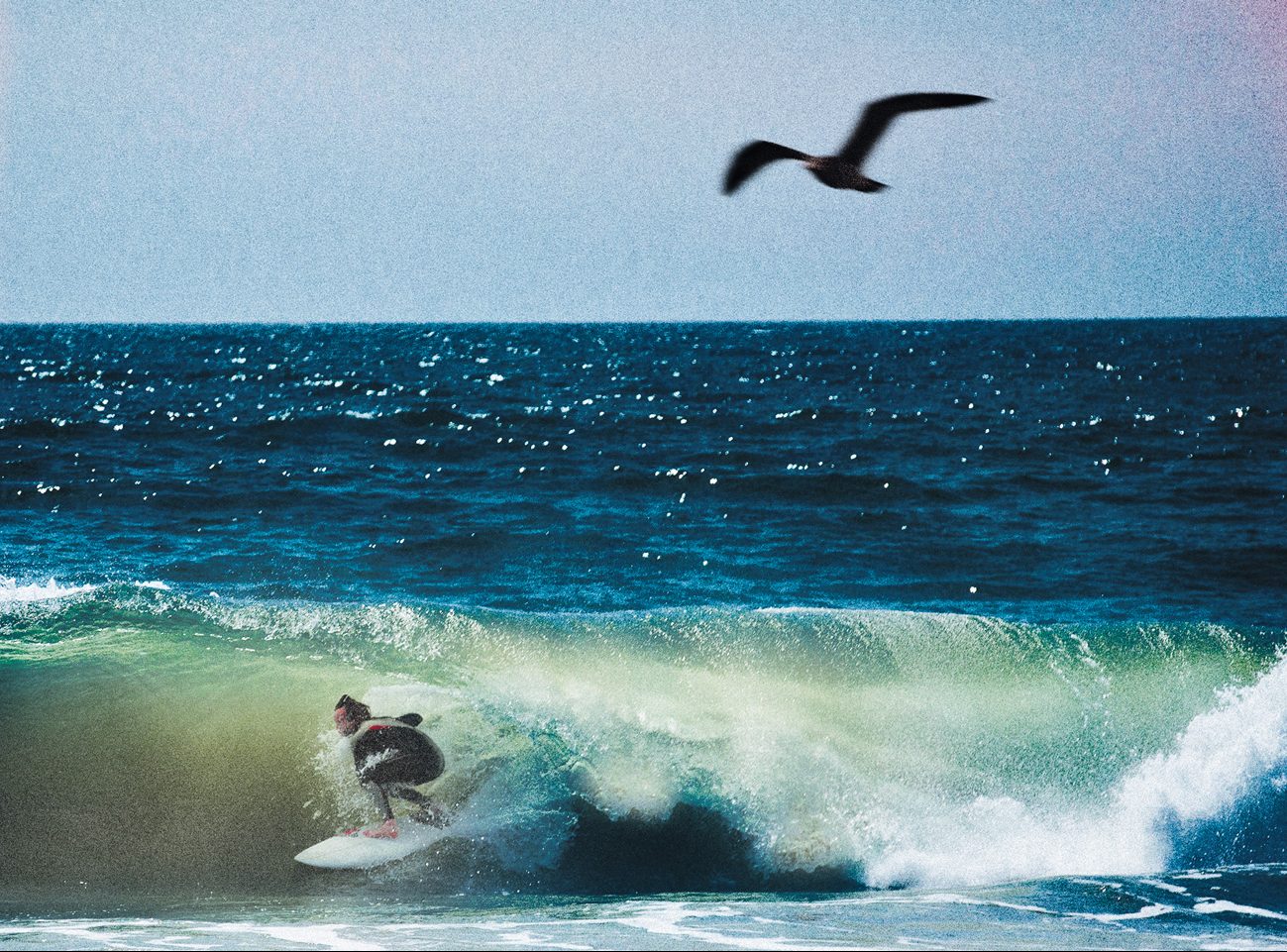
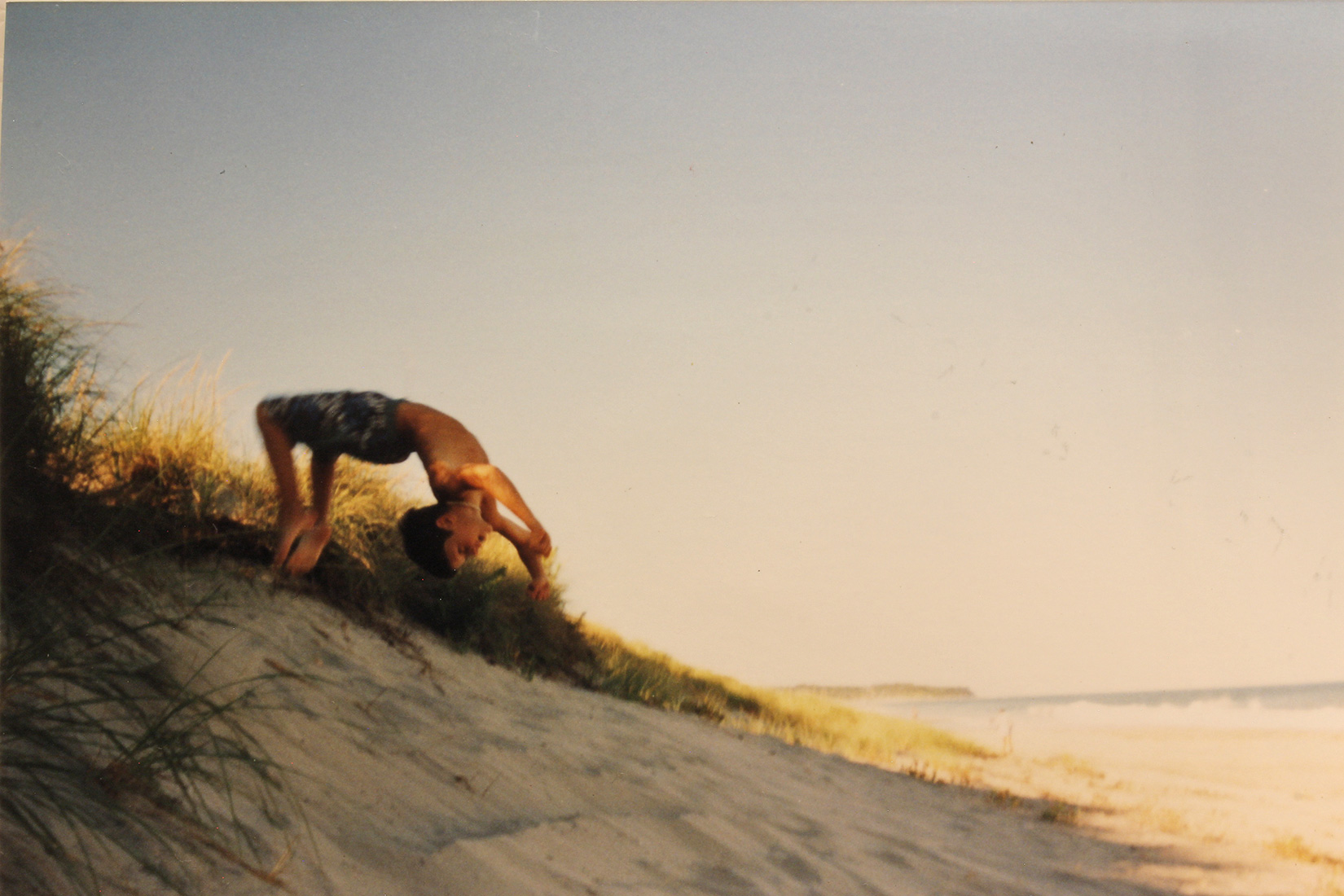
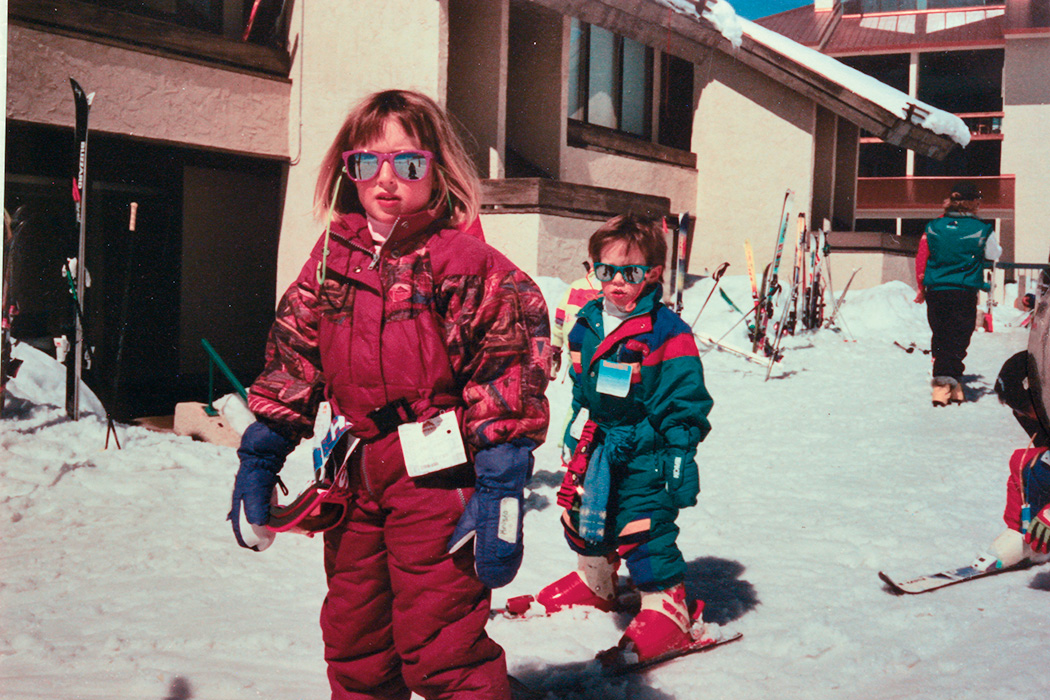
above top to bottom
“It was my first day back home in LA after a three-week ski trip to Russia with Teton Gravity Research. I had the best trip, but I was so happy to be back in the ocean. I love skiing and surfing almost equally, but I need surfing for somewhere to feel like home.”—Clayton Vila Photo: Vila Family Archive
“I learned to do flips by jumping off the sand dunes at home. Before I was seven, I learned backflips, front flips, loops, and so forth. I even did off-axis stuff like cork sevens and misty fives, but I had no idea what the trick names were, so I called them backflip 360s and front flip 180s.”—Clayton Vila Photo: Vila Family Archive
“My sister and I at Crested Butte, CO, when I was three. Our parents tried to take us on a week-long vacation there once a year, and it was one of our favorite times of year. I don’t really remember, but my parents told me that they tried to put me in ski school, but I hated it and would constantly try to ski away from the group.”—Clayton Vila Photo: Vila Family Archive
The Ski Journal: Tell me what you do for a living.
Clayton Vila: I am pretty split down the middle: a professional skier and a film director. I started professional skiing long ago—I turned pro around 19 into 20 and started being able to pay my bills without having to work in the summertime. I’ve been doing that for almost a decade now. Over the past few years, I’ve started to move into directing films and some commercials as well. I’m living in Los Angeles now and [directing] full time.
Why Los Angeles? It makes sense for directing, but for skiing…
Not so much [laughs]. To answer why I moved to LA, I have to go back to where I’m from: Block Island, RI. There’s not a mountain in sight. It’s in the middle of the ocean, literally—an hour boat ride from anywhere. In the summertime, the locals live a kind of California lifestyle—barefoot, board shorts all day long, surfing all the time. [Los Angeles] is a lifestyle I’m used to. I always thought I’d end up there.
Pro skiing kind of came out of left field for me. I loved living in the mountains and pursuing my ski career, but when it came down to it, I just don’t belong in the mountains. And being landlocked wasn’t a thing that worked for me. I decided that I was going to move to LA and travel to ski, which is actually really easy. I live right by the airport, and I get to hop on a plane and go wherever I need to go to go skiing. I can ski in Mammoth and Big Bear whenever I feel like it.
Is surfing still a big part of your life?
I’ve still surfed far more days than I’ve skied. I won’t say anything like, “That’s why I ski a certain way,” but everyone kinda has their sport. What you grew up doing affects you as an adult. And that wasn’t skiing for me. I’m really competitive and I fell into a really good friend group who were all really competitive with skiing. My parents [separated, Robin Vila is a real estate agent on Block Island, while Vila’s father, Rick Vila, a former pilot, now owns a small brush-clearing business] backed me and I just took it and ran with it. But as much as I still love skiing, I try to surf almost every day now, and that’s something that I wanted to get back into my life. The ocean is real. It’s the one sport where you have to give up control. You just gotta let the ocean do its thing.
He’s only a skier these days, for the most part, in the streets of major cities around the world, where it’s Typically hard to find a skier at all.
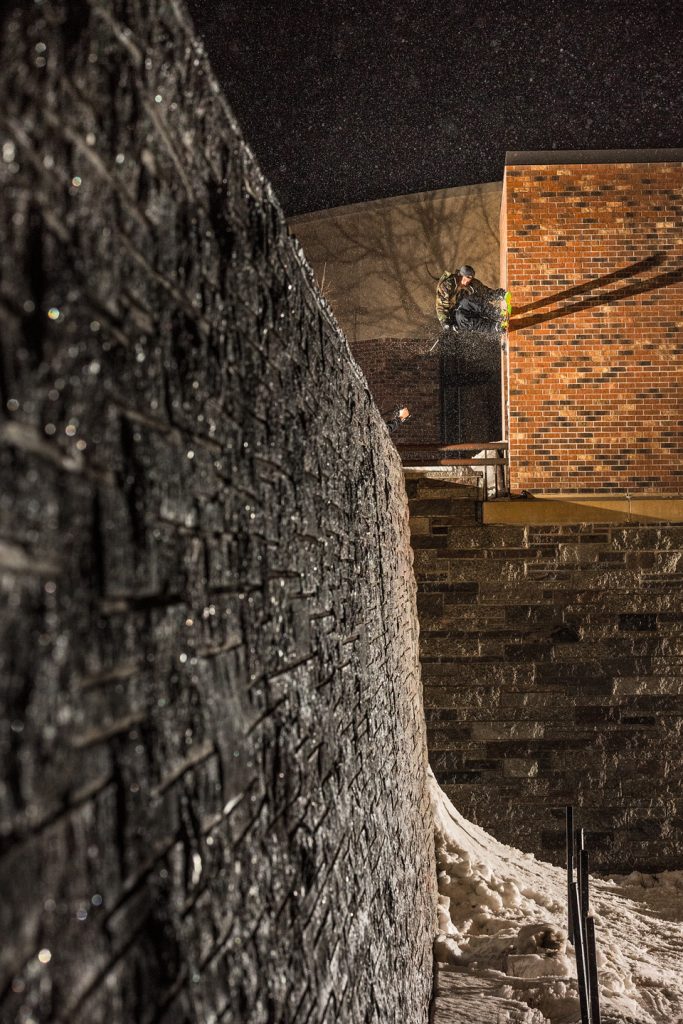
above Vila took to street spots with an open mind, creating an encyclopedia of how and why a trick on a feature would work. Years prior, this would have been just another wall. To Vila, however, it’s a double wall ride. Photo: Erik Seo
That first edit a decade back, your hair was like five feet long, and you were skiing in your backyard to Lil Wayne…
That was when I realized that I could ski rails and maybe have a future. I built a PVC pipe rail in my backyard. I did a bunch of online research and bought some of that Snowflex stuff, the carpet that you could ski on. I learned a ton of tricks on it.
Who were your first sponsors, and how did you end up skiing more?
When I was about 12 years old, all I wanted to do was be a pro surfer or a skateboarder. I was watching Shaun White do it so young, so I said to my parents, “I am going to be a pro athlete in something. Which one will you help me do?” [laughs]
My parents didn’t understand the surf community or the skateboard community, but my Dad was a good skier. When we would go skiing a couple weekends out of the year, he was like, “This kid’s really good, like oddly good.” He said, “If that’s what you wanna do, and you think you got it, then we’ll try to put you in a program.” I enrolled at the Waterville Valley Academy for a month out of the year for the first couple years, then I went for two months through the end of high school. I was able to ski every day, really go hard and learn tricks. We would chuck our meat all day long. That’s where I met all the Stept guys and that’s where we all got serious and competitive. We all fed off each other, and I met a lot of other people who were really taking it seriously too. They weren’t just up there because their parents wanted to get rid of them.
When I first went up there, Michael Clarke and Andrew Hathaway were the top guns. I was like, “I am never going to be as good as these guys.” I was from Block Island, I didn’t know a single person, I had some goofy-ass helmet and mismatched hand-me-down gear and skis that were way too short with bindings that had five DIN max or something. They were like, “Yeah, this isn’t going to work right now.” It was embarrassing.
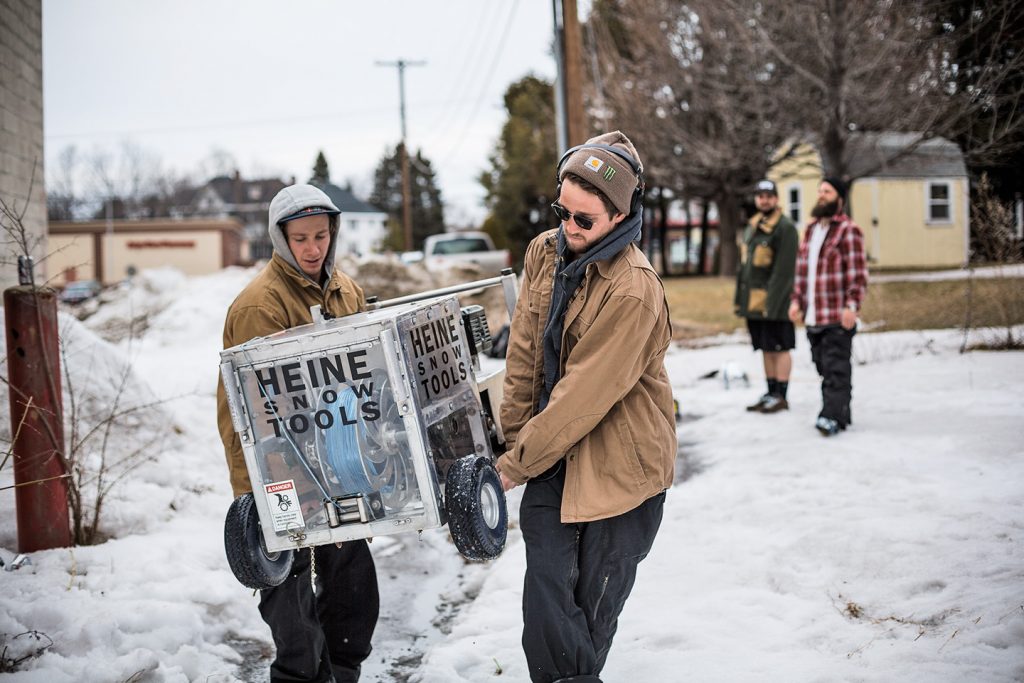
above Custom-built winches, like this one from Heine Snow Tools, can pull a skier as fast as 40 mph. Sometimes costing thousands of dollars, the winch carries with it the benefit of speed, but the disadvantage of sound. In other words, they’re loud. Photo: Erik Seo
How’d you move on from being that kid?
I started competing in New England and met Sean Jordan, and Dale Talkington, who was out in Okemo. LJ Strenio came into the academy for a little bit. Colby West was there, but he was older than me. The list goes on. It’s insane how randomly dominant the East Coast became at that point in time. We didn’t know what we were doing, we were just chucking our meat over ice like idiots.
What was your big break?
I never really had a big break back then because I was just getting good—as good as I possibly could. I was winning a lot of halfpipe competitions in the east, but we didn’t even have a halfpipe at Waterville. I think it was because of surfing, honestly.
I went to nationals at Squaw, got second there, maybe third. I didn’t even care, I just wanted to be a slopestyle skier, ironically. I left high school and moved to Colorado and shifted gears. I dropped everything, left competitive skiing, and lost my sponsors, which wasn’t saying much—I was making a couple grand or something like that. I said, “I’m going to start doing street skiing.”
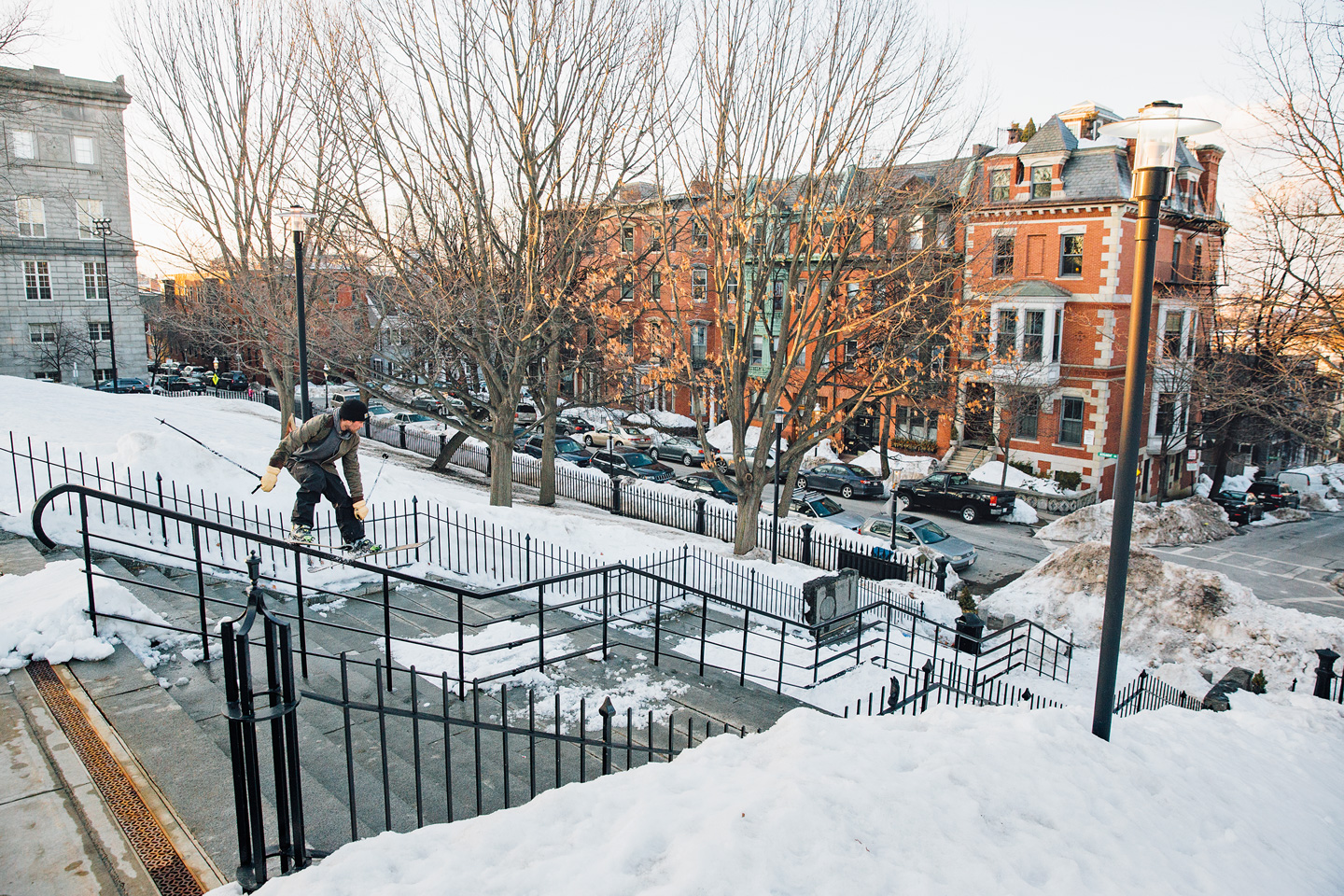
above “This rail in Boston was at the site of the first shot of the Revolutionary War and, coincidently enough, was the last shot of Clayton’s video segment.” Photo: Topher Baldwin
Did 2010’s ‘Network’ change everything for you and the Stept crew?
All the Stept guys moved to Colorado. Some guys got there a year or two before me. Some came a year after. I was pretty much the youngest. We all lived in Boulder. I wasn’t hitting handrails yet—I had only hit one or two handrails at that point in time…one of which ripped half my face off, but that’s a different story.
But I had hit that PVC pipe till it broke in half and felt like I had stuff to add to the street-skiing world. Street skiing didn’t really exist yet—nobody made video parts of 100 percent street. And that was really the vision for Cam [Riley], Nick [Martini] and me. They showed me the ropes—how to build, how to get away from the cops, how to set up generators and lights. It felt so much more “me” because I was doing it with friends and, it sounds corny, but it was more artistic. It was me doing exactly what I wanted to do on skis, finding these locations and expressing myself.
You guys went so big. At a Network premiere another writer asked me, “Which of the Stept kids will die first?”
That shit was so ignorant. We’re able to do this is ’cause we’re not reckless. It’s all an illusion—we have the biggest pads of snow everywhere and we’re smart about it. But we were going for it and that motivation came from Cam Riley. It was my first year trying to [film a street part]. Cam was going crazy and I wanted to, too. And I went right along with him. But I didn’t go nearly as big. From then on, we pushed each other and got smart about it. We’d have a lot of intelligent conversations: “I didn’t think we’d be able to handle that big of a drop but building a landing in that way made that possible. What if we tried it this way? What if we build the jump here? And for this kind of spot, we should build a jump like this.”
All these little things came together: “In-runs are better for these tricks, and winches are better for these tricks.” We were making street skiing into a science. Today, it’s all ingrained in our heads. We wrote an encyclopedia about how to do this stuff. And that’s why we became able to really push it so far.
What brands took notice?
K2 for sure. I had a temporary agent, Zach Davidson, who intro’d me to K2. They picked me up slowly. They watched my segment and said, “We don’t really know what this is all about, but these kids are doing something awesome.”
And that was [former K2 Team Manager/Marketing Manager] Mike Powell. He was the one who signed Cam, myself, Shea Flynn and Sean Jordan. We owe it to Powell because no one else was sponsoring pure street skiers. We were a total experiment. He flowed us for a year, we moved up the ranks, got on the Factory Team, and from there it turned into a decade-long amazing relationship for me.
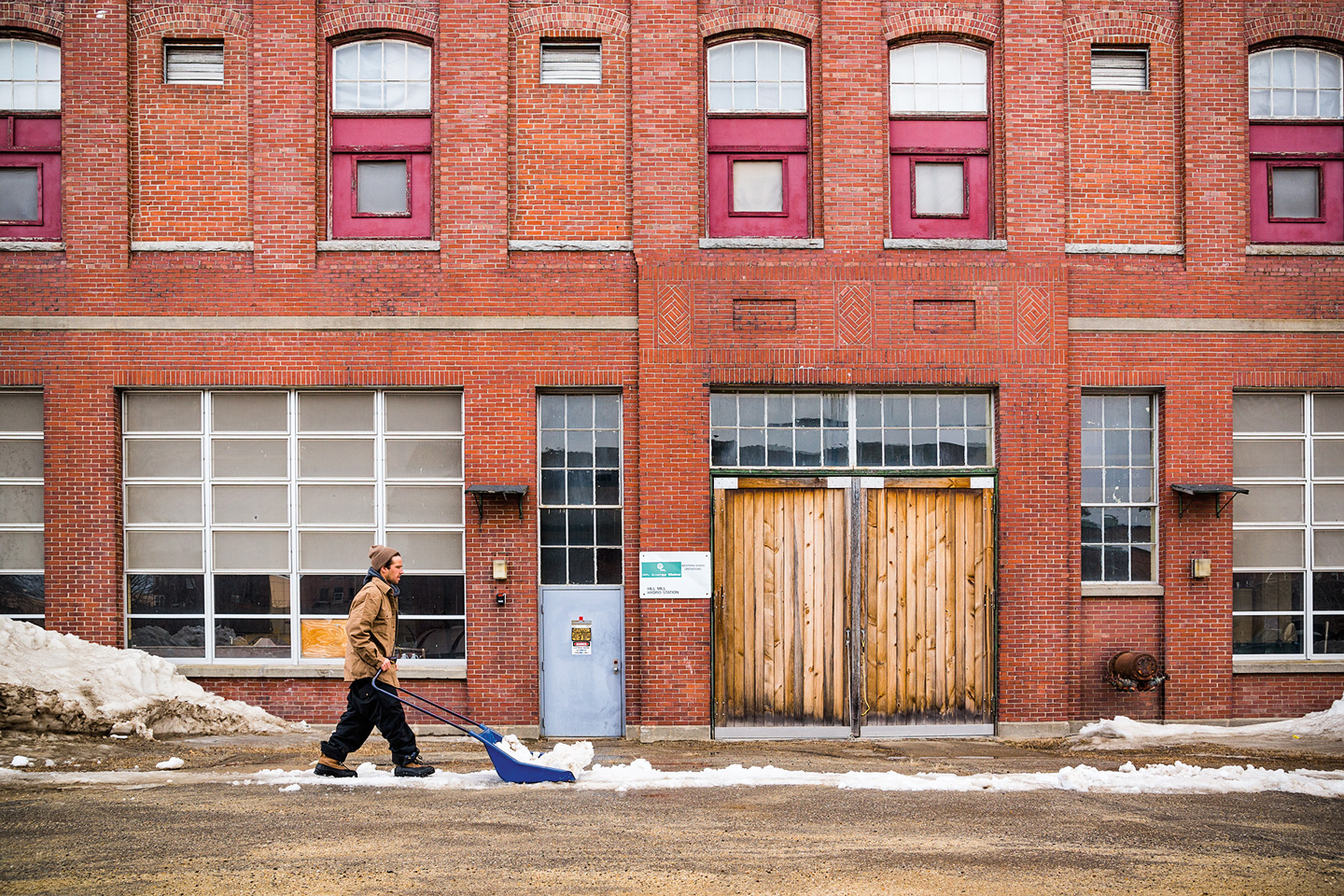
above Vila likes the process of street skiing, which typically involves a lot more work than actual skiing. The gear load can also be heavy, with shovels, water and salt (for firming up takeoffs), winches, bungies, camera equipment and, yes, ski gear. Photo: Erik Seo
From there you’ve been on your own projects—some that were really artistic, some serious ones, some pure ski segments. Why have you tried to diversify the methods of filming, editing and music?
It goes back to why I became a filmmaker. I like the ability to create a segment over the period of a year. I grew up making surf movies with my friends. We had a buddy who filmed it and I learned how to edit, and we’d make a 20-minute movie from 100 days of footage. We put way too much energy into it.
I was already addicted to that process, and I never thought of it like, “Oh, I’m a filmmaker.” I thought of it as, “I’m a surfer who wants to make video parts.” In later years I was like, “Wait a minute, I might be skiing because I’m a filmmaker in a way.” I’ve always been addicted to the craft of creating through the visual medium of film, and I think that all the multiple styles that you’ve seen are just me trying to find my voice—whether it be playing around with abstract visuals or doing a feature documentary. Something inspired me and I pursued it. That all comes back to my love for cinema.
That was always your connection to Teton Gravity Research cofounder Todd Jones.
I owe a lot to that man. He is a mentor and he has had my back more than anybody in this industry. He met Cam and I on a trip to Alaska that K2 lined up for us for TGR’s Dream Factory [2012]. Cam and I still weren’t making any money, so we were up there eating Pop Tarts and staying up to till 1 a.m. filming. Todd hadn’t done a lot of handrail stuff, but we were like, “Check this out. We have some things to bring to the table.”
He liked that we were scrappy dudes. We’re all from New England, we all dropped out of college to be ski bums and make a career out of it, and it worked. He’s had our back ever since—I love those guys.
When I was about 12 years old, all I wanted to do was be a pro surfer or a skateboarder. I was watching Shaun White do it so young, so I said to my parents, “I am going to be a pro athlete in something. Which one will you help me do?”
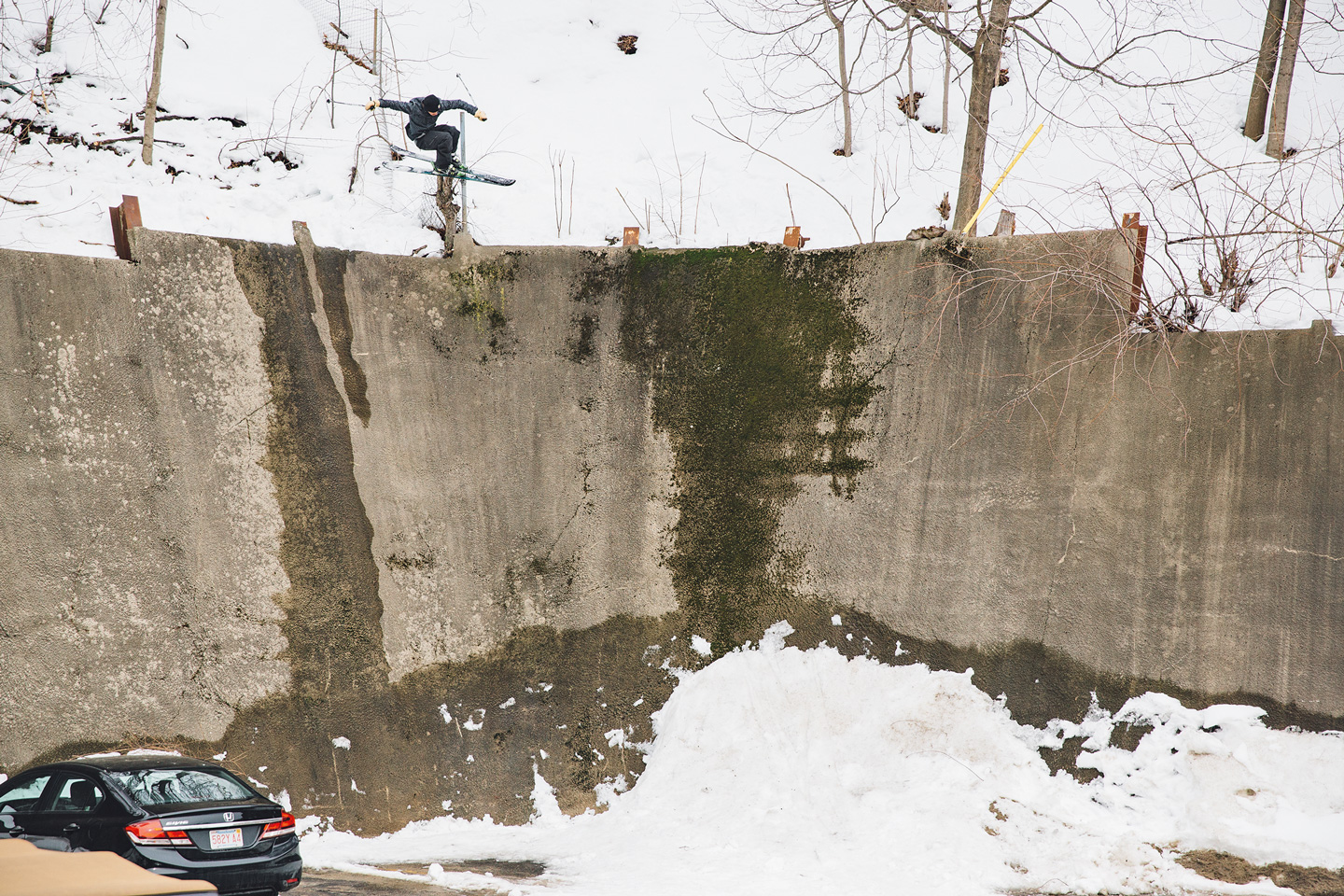
above Clayton Vila, Cam Riley, and the Stept crew were all driven by a blue-collar New England attitude. At the dawn of their careers, no professional skier used urban environments exclusively. Typically, a film segment would feature three to five rail shots to demonstrate the well-roundedness of a skier. Today, Vila makes his living as a professional skier almost exclusively in urban environs. Photo: Topher Baldwin
How do you explain the jump to filmmaking and the improvement over the past few years?
It comes down to experience. Filmmaking is really, really difficult. It takes a lot of finding your voice, a lot of trying and failing. With a bigger budget comes more difficulties and all that. It’s been a slow build and I’ve learned through my ski movies as much as I’ve learned from commercials I’ve made, all the little things. Making a legitimate documentary for ESPN and Red Bull Media House [Back to Life] was my opportunity to put all that experience and knowledge that I’d gained over the years into a legit film. And I was happy with the result—we’ve had a pretty good response.
Is it more difficult for you to figure out the technical aspects of storytelling or the artistic side? Which do you like more?
I learned about screenwriting through For Lack of Better. That film I did about me, Sean and Cam was a crash course. It was about the science behind what we do, and an interesting look into the niche of street skiing in the [ski] industry. I went at that like, “Yeah, there’s documentary potential here.”
I spoke to a story consultant, this amazing documentary filmmaker in Boulder. He was a friend of a friend, and I was like, “Hey, you made a documentary. What am I doing wrong?” And he was pretty much like, “Everything!” He helped me rearrange my story and enlightened to how it’s done. Everything in filmmaking is gained through experience except for screen writing, which is based on theory.
I learned what screen writing was and that whole experience was fun. I didn’t really know what I was doing so I spent two years studying screen writing before I made Torin’s film. I’m inspired by it, and I want to be a legitimate filmmaker, and find the next story and be able to recognize it and be confident that I can execute it. Toward the tail end of that study period, Torin went into a coma, came out of it, and won the Winter X Games. And I was like, “O.K., that’s the end of the story. That is a point of hopelessness and climax.”
I hit him up like, “Hey, I know you liked my last film, I want to hear about the beginnings of your life.” We started to peel off layers of the onion, and learned about his father going to prison, and all that crazy stuff that happened earlier in his life.
I told him, “I really know what I’m doing here. Check out this book with all my studies of writing and all I’ve learned about this. I really think we can make an amazing film.” He was down—he gave me a shot on it, which I’ll be forever grateful for. I was confident, but it was an extremely complex story. It really, really tested my knowledge. It was very difficult to find a way for everything to line up. It was a complicated story to tell. We had to move things around and do it nonlinear, which required some really gutsy moves. We also had to do re-creations which is a terrifying game.
Pro skiing kind of came out of left field for me. I loved living in the mountains and pursuing my ski career, but when it came down to it, I just don’t belong in the mountains. And being landlocked wasn’t a thing that worked for me.
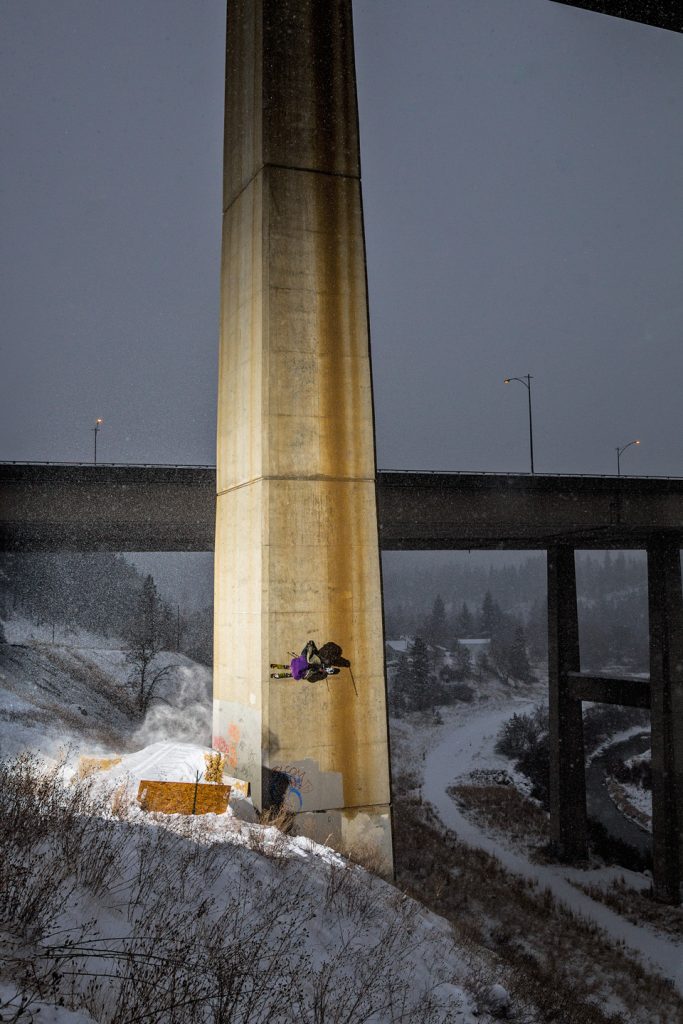
above “Sometimes there is enough snow to build the jumps and landings big enough for the size of the feature. And then there’s this time, where after a long build, trying to gather enough snow, we gave up and went hunting for hay bales. We finished with just enough light left in the day for Clayton to get a few hits on this wallride and get his shot in Spokane, WA.” Photo: Erik Seo
How many people worked on that film with you?
We had a crew of 20-plus people on set shooting the re-creations. In the back end, there’s a post-production team of five or so. We had five executive producers, and all their teams at Red Bull Media House. In total the credits roll over a hundred people or something like that. At the end of the day, it’s a tight-knit little team who are there the entire time: myself; my producer Matt Brady, who is an amazing producer in Hollywood and was gracious enough to pick up the film; Matthew Pothier, who actually I knew from Waterville, was our director of photography. They were a few of the key players the whole way through.
It premiered on ESPN?
We had an ABC air date. It also went on Red Bull TV for a while. It’s on Amazon Prime now, too, which is a pretty cool deal. It’s in film festivals, which are Oscar qualifiers, so I’m excited about that.
Now what? You’re still skiing for TGR…
I’m in the TGR movie as usual, which is exciting. We went to the Kamchatka Peninsula in Russia, which took 60 hours of flights. It was extremely remote and extremely interesting. I’m hoping this year that I get to get after it a little more and really focus on skiing. At the same time, I’m trying to get ready for the next film—hopefully it will be a feature narrative that I’m currently writing with a partner and trying to get it funded. That’s my next big jump.
This article first appeared in The Ski Journal Issue 12.2.
